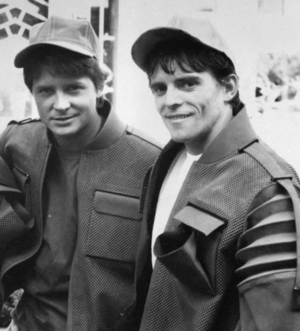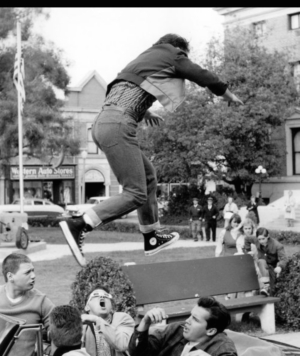Interview: Stunt Coordinator Charlie Croughwell Talks The Laundromat and Back to the Future
 39-year veteran stunt coordinator, Charlie Croughwell, speaks with us about his work on the new film The Laundromat and how he got his start in Back to the Future.
39-year veteran stunt coordinator, Charlie Croughwell, speaks with us about his work on the new film The Laundromat and how he got his start in Back to the Future.
When did you first get into doing stunts and when did you know you wanted to do this as a career?
I began pursuing stunts in 1980. I think it was written in the stars. As long as I can recall, my friends, family and I would stage crashes, choreograph fights, rock climb, put on skits for the family (usually during holidays) and create general mayhem any chance we had.
You began your stunts career as Michael J. Fox's stunt double in Back to the Future, what was it like working on that film?
Back to the Future, specifically the first one, was a fantastic learning experience for someone just getting their career started. Bob Zemeckis and Bob Gale are incredible storytellers. Being able to be a part of their process exposed me to so many different scenarios that would typically take years to experience.
You gradually became a stunts coordinator, why did you decide to pursue this?
I was originally interested in directing and had an eye on performing stunts. Then I moved up to stunt coordinating and directing second unit.
Most recently, you worked as the stunts coordinator on the upcoming Meryl Streep film, The Laundromat, how did you get involved with this film?
The film's producer, Michael Polaire, whom I've known for years, contacted me.
I think I was primarily chosen for two reasons.
- We rolled a plane full of people for the film Flight, which was similar to our boat rollover.
- I have a strong background in water related stunts and the boat rolling upside down in water required a great need for equipment and expertise to safely execute 37 elderly (80 years old and up) people ending up trapped inside an upside down boat. The safety required was greater than the plane scene from Flight.
What was the process like when planning and filming the tour boat capsize scene?
We first had to identify 37 elderly folks (over the age of 80 preferably) that were also very strong watermen and women. We recruited some veteran stunt people that had strong backgrounds in the water world but also went outside of the industry and brought in people who spend a majority of their lives in or on the water. We then had to ensure that each and every person would be able to escape the overturned boat under their own power. We had 14 water safety people in and around the water and boat to monitor the people and lend assistance if necessary. Our 14 people consisted of, not only industry veterans, but highly trained, retired Navy SEALs. We also had some SEALs on the boat as performers.
We first rolled the boat without anyone aboard, with all of the stunts people watching from the sidelines and the safety teams in their positions to observe the boat throughout its capsizing. This is important as everyone has the chance to observe the mechanical aspects of the process during rehearsal and can identify any unforeseen issues that might arise. All of our safety personnel had additional air supplies if anyone needed it, and the boat was also equipped with  additional safety equipment in case someone got stuck and needed air.
additional safety equipment in case someone got stuck and needed air.
Do you work a lot with the director and/or director of photography when coming up with stunts and choreography to make sure it all works with the camera angles?
The director is the primary contact on all productions. They are the storyteller and our job is to assist them and provide the elements required to achieve their desired results.
Making films, TV, or live performances is much like a jigsaw puzzle when broken down. Each department assists in providing the Director and DP with pieces of the puzzle that are later assembled by the editor.
I'm assuming you determine pretty early on which actors can do their own stunts. Is there a certain point you draw the line and bring in a stunt double?
The stunts or action sequences dictate where stunt doubles or additional stunt people will be required. Some actors can do their own stunts and some can't. It all depends on who they are, what they're comfortable with and the safest approach. Once I've met with the actors and have discussed specific scenes, we can determine how involved they can be in the stunt execution.
You also were the stunts coordinator on Disney's upcoming live-action CGI-animated film, Call of the Wild, what is it like creating stunts for a film that will involve animation?
The animation process and CGI provides greater flexibility in what I'm able to offer, sometimes with CGI enhancements.
Many elements come into play when working in an animated world. We work with the physical effects department, visual effects department, and performance related elements in a much more inclusive method when designing action pieces for animated productions.
I love the process.
Is there a stunt that you've coordinated or performed over your career that stands out to you as your favorite?
Each and every stunt, however similar to stunts I've performed or coordinated, is unique to the specific application for the story. Choosing one stunt as my all-time favorite is very difficult but if I had to choose, it would be the Hoverboard sequences from Back to the Future.
Where do you get inspiration from when coming up with stunts for scenes?
The inspiration for various stunts come from a wide variety of places including life's experiences!
A few examples:
On How the Grinch Stole Christmas, I asked my kids (3,7, and 9 at the time) what they thought was cool as we were holding "Who School" where we developed the "Who Movement" with the cirque performers I brought in to play the parts. From their input we created acts that were similar to what kids do best: play. As all Who's should do. The inspiration for the cirque performers and "Who School" came from discussions Ron Howard and I had regarding all of the action.
On Planet of the Apes (Tim Burton's version), we held "Ape School" on my property. All of the stunt people and actors had to attend. One of the cirque performers I brought on for Grinch, Terry Notary, I brought back for Apes. Terry and I would analyze various ape movements and attempt to apply it using Terry as the test subject. We did this by watching videos, visiting zoos and once again, including my kids by having them mimic what they thought apes moved like. Then we developed human quadrupedal movements (walking on all fours) and were comfortable with its appearance. There was a huge battle sequence in the film where the apes and chimps charge the humans and a battle ensues. This required speed.
On the film What Dreams May Come we had a scene with Robin Williams running very quickly across the countryside and wanted to do it for real.
Discussing this with the special effects supervisor Roy Arbogast, he mentioned that he had once used the belt from a conveyor belt hooked to a truck and dragged along a road to make it appear that the actor was effortlessly floating along the ground.
So, we bought one, hooked it to a truck, I got on the far end (crouched down at first) the truck took off and accelerated to about 25 mph. When it was tracking properly I stood up and ran to the other end. I was traveling anywhere from 30-40 miles per hour. It was an awesome shot. It's the same sensation as a moving sidewalk in an airport.
While I was watching Terry trying to run on all fours, it was obvious he couldn't go fast enough. So in came the same belt we used on What Dreams. The script specified that the chimps were passing horses. I called a friend who brought his horse over, put my truck and conveyor on the road, sent the horse on its way, and caught up to and passed the horse with Terry running on all fours.
We had another scene in What Dreams with Robin stepping off a mountain top in heaven and falling into a large patch of flowers where he then gets up and begins running. The producers showed me a small hill in Montana, with a garbage dump below that they had hoped we could make work. There was nothing good about this location. Some skydiving friends of mine had once BASE jumped from Angel Falls in Venezuela and had shown me the footage years before. I recalled that it looked like heaven. So I pushed the idea to the producers who took it to the studio and when filming was complete they asked me to go jump off Angel Falls and film it. I took a small crew with me, we camped in the jungle across from the falls and spent two days jumping and filming with two Robin doubles, aerial camera jumpers and cameras hanging off of the side of the mountain (3,212 feet off the ground). It was very exciting. We helicoptered to the top each morning and jumped until the fog forced us out, which was usually around 11 a.m.
Is there one person you'd love to collaborate with that you haven't yet?
There are so many that it would be difficult to choose just one. I've worked for Steven Spielberg on many projects, both as a stunt performer and stunt coordinator and he worked as a producer on all of them. I think I'd like to be his stunt coordinator/second unit director on a project.
If I sat here long enough I could list 100s of people that I'd like to collaborate with. A few directors/producers I'd love to work with are: Leonardo DiCaprio, James Cameron, Kathryn Bigelow, Quentin Tarantino, Ridley Scott, and Catherine Hardwicke. Some actors I'd like to work with are: Liam Neeson, Chris Hemsworth, Ryan Reynolds, Julia Roberts, Scarlett Johansson, and Robert Downey Jr.
Each one has a reputation, be it as an amazing director, producer, or actor. They all approach the process of storytelling differently and in their own way.
If you ever have the opportunity to quietly watch Jim Carrey or Anthony Hopkins prepare for a scene, both are amazing actors, but more importantly, they positively inspire me and how I approach my job. If I can go in and tap into the emotional aspect of a particular piece, then I can give them something to work from. Understanding not only the performance they're looking for but what image they have rattling around in their brain is probably the most rewarding part of my job. You have to give them what they need, like pieces of a puzzle that they can use to craft their approach.
Do you have any advice for aspiring stunt coordinators or performers, like anything you wish you knew when you were starting out?
Don't lose sight of your goal yet stay very flexible and open minded. Things change quickly in this process. You need to anticipate and be prepared for any changes that may be sprung on you. Be prepared for anything, always! And most importantly, enjoy your job and always have a positive attitude. Not many people get to exist in this world and it's an honor to be able to.
Do you have other upcoming projects you could tell us about?
I do, but am bound by NDAs. I wish I could, they're all very exciting in their own right!
PHOTOS COURTESY OF CHARLIE CROUGHWELL
Comments
Videos

